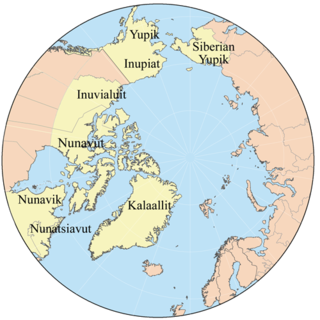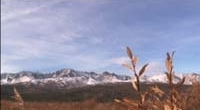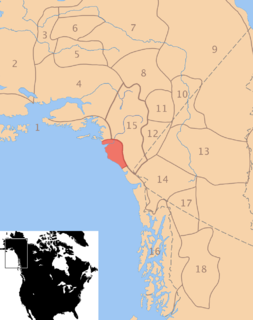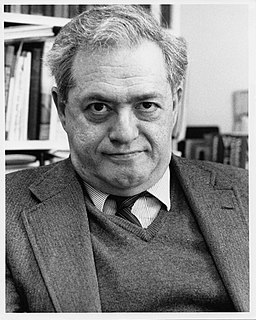The Alaska Native Language Center, established in 1972 in Fairbanks, Alaska, is a research center focusing on the research and documentation of the Native languages of Alaska. It publishes grammars, dictionaries, folklore collections and research materials, as well as hosting an extensive archive of written materials relating to Eskimo, North Athabaskan and related languages. The Center provides training, materials and consultation for educators, researchers and others working with Alaska Native languages. The closely affiliated Alaska Native Language Program offers degrees in Central Yup'ik and Inupiaq at the University of Alaska Fairbanks, and works toward the documentation and preservation of these languages.
In 1974, Michael Krauss published a language map of Alaska, which he later updated in 1982. It has remained the standard since then. In the summer of 2011, the Alaska Native Language Center made an update to Krauss's map. [1] One of the biggest reasons for this update was that some of the names of these languages had changed over the years. While there was not a dramatic change in the updated map, the new edition is entirely digital. [2]
| Language | Population | Speakers | Percent Speakers |
|---|---|---|---|
| Ahtna | 500 | 80 | %16.00 |
| Aleut | 2,200 | 300 | %13.64 |
| Alutiiq/Sugpiaq | 3,000 | 400 | %13.33 |
| Dena'ina | x | x | x |
| Deg Xinag | 275 | 40 | %14.55 |
| Eyak | 50 | 0 | %0.00 |
| Gwich'in | 1,100 | 300 | %27.27 |
| Haida | 600 | 15 | %2.50 |
| Hän | 50 | 12 | %24.00 |
| Holikachuk | 200 | 12 | %6.00 |
| Inupiat | 13,500 | 3,000 | %22.22 |
| Koyukon | 2,300 | 300 | %13.04 |
| Tanana | 380 | 30 | %7.89 |
| Tanacross | 220 | 65 | %29.55 |
| Tlingit | 10,000 | 500 | %5.00 |
| Tsimshian | 1,300 | 70 | %5.38 |
| Upper Kuskokwim | 160 | 40 | %25.00 |
| Upper Tanana | x | x | x |
| Yup'ik, Central Alaskan | 21,000 | 10,000 | %47.62 |
| Yupik, Siberian | 1,100 | 1,050 | %95.45 |

Eskimo is an exonym used to refer to two closely related Indigenous peoples: the Inuit and the Yupik of eastern Siberia and Alaska. A related third group, the Aleut, which inhabit the Aleutian Islands, are generally excluded from the definition of Eskimo. The three groups share a relatively recent common ancestor, and speak related languages belonging to the Eskimo–Aleut language family.

Tanacross is an endangered Athabaskan language spoken by fewer than 60 people in eastern Interior Alaska.

Athabaskan is a large family of indigenous languages of North America, located in western North America in three areal language groups: Northern, Pacific Coast and Southern. Kari and Potter (2010:10) place the total territory of the 53 Athabaskan languages at 4,022,000 square kilometres (1,553,000 sq mi).

Eyak was a Na-Dené language, historically spoken by the Eyak people, indigenous to south-central Alaska, near the mouth of the Copper River. The name Eyak comes from a Chugach Sugpiaq name (Igya'aq) for an Eyak village at the mouth of the Eyak River.

The Eyak are a Native American indigenous group historically located on the Copper River Delta and near the town of Cordova, Alaska. Today, Eyak people live in Cordova, Yakutat, across Alaska, and the U.S. Many of them do not qualify to be tribal members in the native village of Eyak, a federally recognized Alaska Native tribe which was established through the Alaska Native Claims Settlement Act in 1971. This is due to the enrollment qualifications that extend tribal membership only to those who reside in the town of Cordova for the majority of the year.
Central Siberian Yupik, is an endangered Yupik language spoken by the indigenous Siberian Yupik people along the coast of Chukotka in the Russian Far East and in the villages of Savoonga and Gambell on St. Lawrence Island. The language is part of the Eskimo-Aleut language family.

Michael E. Krauss was an American linguist, professor emeritus, founder and long-time head of the Alaska Native Language Center. He died on August 11, 2019, four days before his 85th birthday. The Alaska Native Language Archive is named after him.

Deg Hitʼan is a group of Athabaskan peoples in Alaska. Their native language is called Deg Xinag. They reside in Alaska along the Anvik River in Anvik, along the Innoko River in Shageluk, and at Holy Cross along the lower Yukon River.
Deg Xinag is a Northern Athabaskan language spoken by the Deg Hitʼan peoples of the GASH region. The GASH region consists of the villages of Grayling, Anvik, Shageluk, and Holy Cross along the lower Yukon River in Interior Alaska. The language is severely endangered; out of an ethnic population of approximately 250 people, only 14 people still speak the language.
Babine–Witsuwitʼen or Nadotʼen-Wetʼsuwetʼen is an Athabaskan language spoken in the Central Interior of British Columbia. Its closest relative is Carrier. Because of this linguistic relationship together with political and cultural ties, Babine–Witsuwitʼen is often referred to as Northern Carrier or Western Carrier. Specialist opinion is, however, that it should be considered a separate, though related, language.
Koyukon is the geographically most widespread Athabascan language spoken in Alaska. The Athabaskan language is spoken along the Koyukuk and the middle Yukon River in western interior Alaska. In 2007, the language had approximately 300 speakers, who were generally older adults bilingual in English. The total Koyukon ethnic population was 2,300.
Holikachuk was an Athabaskan language formerly spoken at the village of Holikachuk (Hiyeghelinhdi) on the Innoko River in central Alaska. In 1962, residents of Holikachuk relocated to Grayling on the lower Yukon River. Holikachuk is intermediate between the Deg Xinag and Koyukon languages, linguistically closer to Koyukon but socially much closer to Deg Xinag. Though it was recognized by scholars as a distinct language as early as the 1840s, it was only definitively identified in the 1970s. Of about 180 Holikachuk people, only about 5 spoke the language in 2007. In March 2012, the last living fluent speaker of Holikachuk died in Alaska.

The Yup'ik or Yupiaq and Yupiit or Yupiat (pl), also Central Alaskan Yup'ik, Central Yup'ik, Alaskan Yup'ik, are an Indigenous people of western and southwestern Alaska ranging from southern Norton Sound southwards along the coast of the Bering Sea on the Yukon-Kuskokwim Delta and along the northern coast of Bristol Bay as far east as Nushagak Bay and the northern Alaska Peninsula at Naknek River and Egegik Bay. They are also known as Cup'ik by the Chevak Cup'ik dialect-speaking people of Chevak and Cup'ig for the Nunivak Cup'ig dialect-speaking people of Nunivak Island.

As of 2019, Alaska has an estimated population of 731,545.
Dené–Yeniseian is a proposed language family consisting of the Yeniseian languages of central Siberia and the Na-Dené languages of northwestern North America.
Nunivak Cup'ig or just Cup'ig is a language or separate dialect of Central Alaskan Yup'ik spoken in Central Alaska at the Nunivak Island by Nunivak Cup'ig people. The letter "c" in the Yup’ik alphabet is equivalent to the English alphabet "ch".
Alaska Natives are a group of indigenous people that live in the state of Alaska and trace their heritage back to the last two great migrations that occurred thousands of years ago. The Native community can be separated into six large tribes and a number of smaller tribes, including the Iñupiat, Yup'ik, Aleut, Tlingit, Haida, Tsimshian, and others. Even with just a small amount of communities that make up the entire population, there were more than 300 different languages that the Natives used to communicate with one another.
The Michael E. Krauss Alaska Native Language Archive (ANLA) in Fairbanks, Alaska, is an extensive repository for manuscripts and recordings documenting the Native Languages of Alaska. The Archive was created as part of the Alaska Native Language Center by state legislation in 1972. In 2009 the Archive was administratively separated and now exists as a sister organization to the Alaska Native Language Center, collaborating on numerous language efforts in Alaska.
Proto-Athabaskan is the reconstructed ancestor of the Athabaskan languages.
Irene Reed, was an American anthropologist, linguist and educator, central in preserving and promoting the Yup'ik language in Alaska.